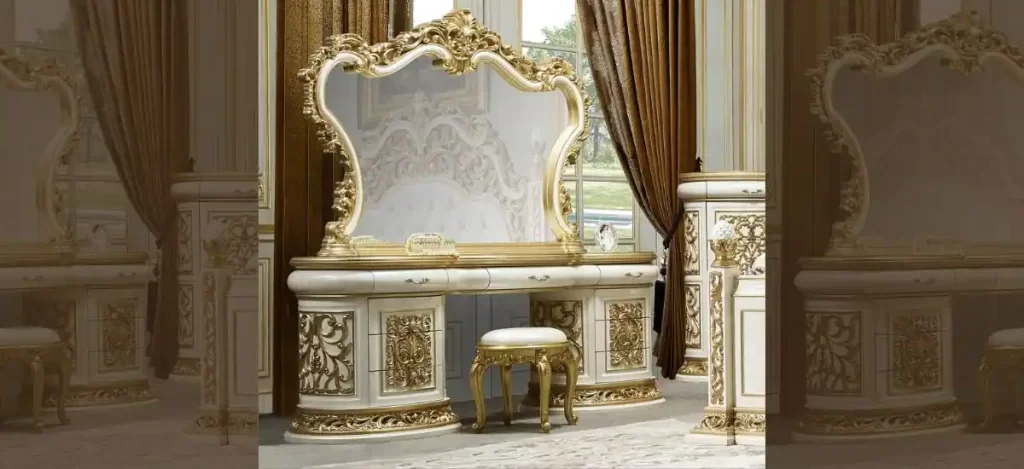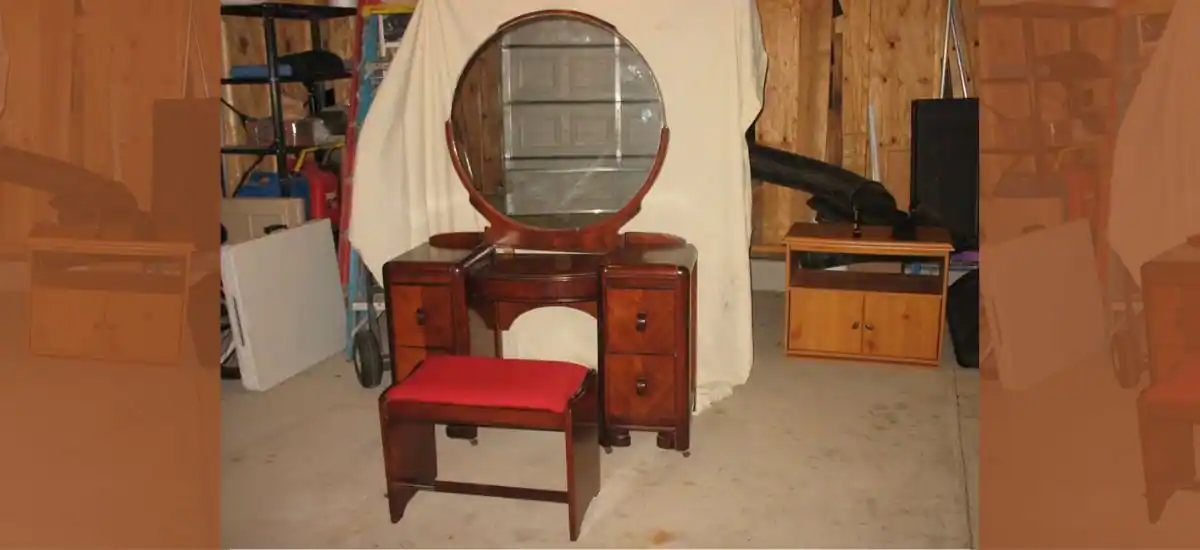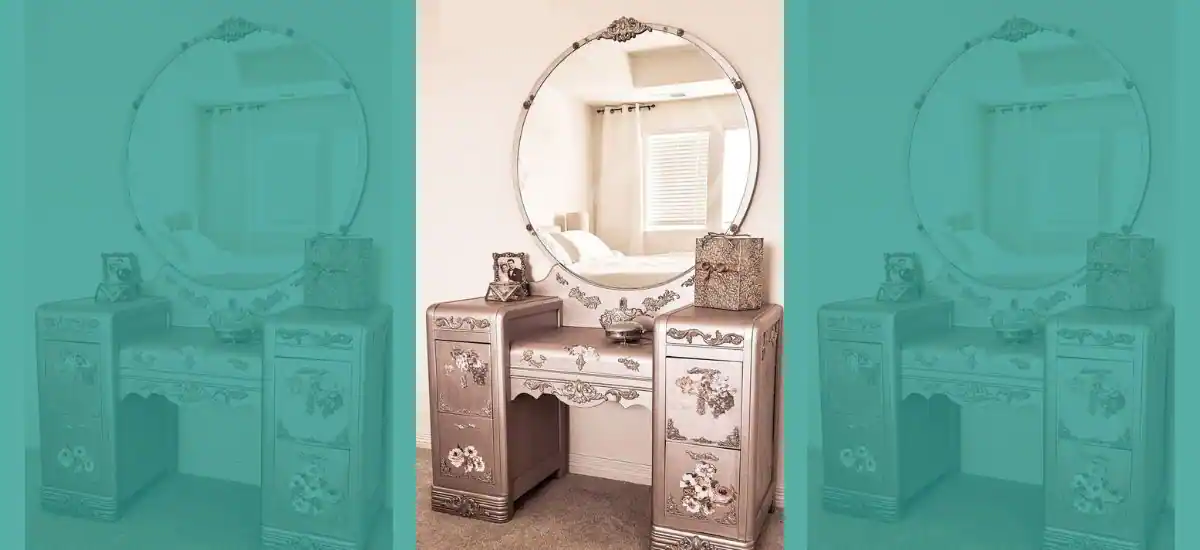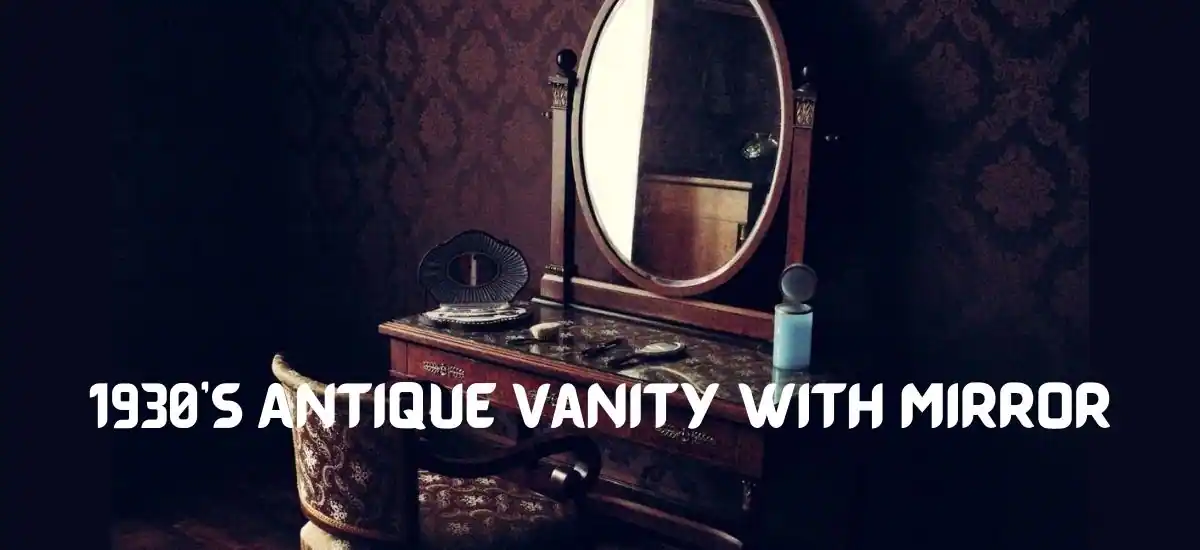Any mirror created at least 100 years ago is considered an antique. Because the appearance of old mirrors never goes out of style, contemporary designers occasionally create mirrors that resemble antiques. Simple glass inspection is one of the easy ways to determine how old a mirror actually is.
Funny thing is, the likelihood that the glass is ancient increases with the number of faults on it. It’s common for mirrors to have bubbles, folds, or stains due to the older, less sophisticated production method.
Examining the mirror for markings that can identify the manufacturer, such as a name and date or the artisan’s signature, is another approach to determine if it is a genuine antique.
Many ancient mirrors were handcrafted, therefore there are few indications of the artist’s identity.
Identifying Antique Vanity By Yourself

Experts recommended the following specific considerations for identifying antique vanities:
Considering The Entire Structural Design
The most crucial indicator of an item’s age is still its random irregularity. You must examine the joinery more closely.
Pieces made by hand only have perfect evenness in concealed areas. So, pay special attention to the interior, internal, and bottom surfaces.
Investigating Materials to Find the Perfect Match
The dresser’s little matching components should have a tiny shape distortion.
Not everything can be exactly styled as it ought to be. It relates to the door handles, drawer pulls, or associated legs. The configuration for a vanity created by a machine, however, exactly matches the individual elements.
Setting Documentation For Quick Research: It’s still a good idea to explore the entire building for any identification signs. Any specific stamp, logo, or signature can be used to identify the manufacturer.
Additionally, you must search the library for proof. Verifying the legitimacy is necessary to prevent a perplexing purchase.
Examining The General Surface Condition: The exterior surface provides numerous valuable hints that can be used to assess any furniture’s viability.
To structure the design, you must determine the real sort of wood. To look for signs of repair, refurbishment, or restoration, consult professionals.
Try to go for well-maintained designs that have undergone little to no alteration.
Investigating Its Holding Screws On Joinery: In the meantime, replicas of vintage screws are practically impossible to come across.
Early hand-made screws were used on round or square nail stocks. Additionally, the heads of early machine-made screws need to be hacksaw polished.
As a result, no two screws may even remotely resemble an antique.
Integrated Hardware Accessory Evaluation
Brass or plain iron hardware is another example of outdated hardware. The bulk of early vanities are covered with molten brass and require sand molds. On the inside of the sides, the exterior polish left pockmarks.
The early artisan chronology is indicated by the rough texture, simple polish, and inadequate threading.
Should You Restore an Antique Mirror?

The issue with attempting to increase an antique’s worth through restoration is that frequently, altering a real antique may reduce its value or distinctiveness. Because of this, specialists usually advise leaving the restoration of antique mirrors to them.
Mirrors that are older can be updated in a number of ways. The rear coating can be changed if the glass has de-silvering areas all over it.
But when new silver is put on the back, old glass’s propensity for scratches or haziness is highlighted. The reflection gets distorted and warped when the glass is polished. Additionally, the glass itself has no intrinsic worth unless it is inscribed.
For all of these reasons, many experts simply suggest replacing the glass.
You are now well on your way to figuring out whether your mirror really is an antique, how much value it actually has, and whether it is worth the time and effort to restore.
Guide On: Vintage Glass Bottle Markings
What Is the Value of an Antique Mirror?

If an antique mirror is one-of-a-kind or the only one left, that fact raises its worth. Check online to check if the company, the style, or the artist’s (if you can identify them) creation is unusual.
Unusual furniture is owned by many people, and many of them are unaware of its worth. To determine how old a mirror is, look at the back.
While newer mirrors typically have a paper backing, many ancient mirrors have all-wood backs.
Vanity Vs Dressing Table – Are Both The Same?
Vanity is referred to by far too many words, including bureau, dresser, lowboy, and dressing table. Beginner collectors frequently have a very difficult time determining the difference.
In actuality, most common people interchangeably use the aforementioned terms.
However, a brief form of a typical dressing table is all that is meant when the word “dresser” is used. Lowboy, however, is a common American metaphor for vanity.
Once more, rather than dressing tables, the bureau is more a lost or underutilized term for an antique vanity. Not to mention that the traditional vanity actually predates the dressing table of today.
There are simply a few drawers on each of its two sides. Additionally, it allows a gap in the middle to support the user’s legs. And a lot of decorative elements are incorporated into the design.
And a dressing table varies from vanity in that it has a forced mirror. A different layout of additional chest drawers is present.
Old-fashioned vanities have been updated, polished, and transformed into dressers. Modern design can serve multiple, distinct functions at once.
Know About: Tom Clark Gnomes, Rare And Valuable
Brief Timeline Of Early Vanity Designs

The evolution of vanity design seems more like a trend than a change. As a result, antique vanity appeal has a rich past that can withstand the test of time.
Toilette Table
This was arguably the first official vanity table to draw the attention of the general public.
Handkerchiefs used to keep cosmetics are referred to as toiletries in French. Some designs even included tiny water basins for washing one’s face.
French Desk
Reputable royal advisor Madame Pompadour chose eminent French furniture makers for the position.
She also had a well-known vanity table made by Jean-François Oeben. Rocco-style architecture houses magnificent 18th-century artwork.
Dressing Table
Vanity gradually takes on the ‘Dressing Table’ name to become an essential bedroom component.
By the 19th century, it had made it to both England and America. Among the wealthy, Queen Anne’s designs were all the rage.
Mirror Table
Thanks to industrial advancements, glass becomes more affordable by the 1900s.
Tri-fold mirror tables also quickly gained popularity. It put together an oval central mirror with two wing mirror supports on either side.
Waterfall Vanity
Starting in the 1930s, the Art Deco style was in full force. It created Waterfall with a single, substantial circular mirror.
Simpler structural features and exotic veneers were combined in the less elaborate design.
Mid-Century Vanity
Modern décor was distinguished by curved elements, stiff materials, and clean lines.
Even changing to mirrors with unique shapes as possible with adjustable mirrors. The streamlined appearance opened the door for contemporary designs despite its understated elegance.
Early in the 1970s, style, and fashion underwent a literal wild revolution.
Nearly anything was tested by manufacturers to determine the viability of new designs. Finding a believable vanity design to support the inside décor, however, is challenging.
Streamlined Vanity
The appeal of the vanity was enhanced by its modern design’s distinct streamlines.
It introduced the tray, organizer, and storage trends, among others. And for some reason, the brass finish was applied to nearly every design.
By the twenty-first century, vintage vanity had reached its conclusion. You can achieve a somewhat more modern look with ease, of course.
But a thorough investigation will be needed to verify legitimate designs from the 17th through the 20th century.
Also Read: What Are Benjamin Moore Antique Jade
Frequently Asked Questions
1. When was the vanity mirror invented?
The development of vanity in its modern form started in Europe in the late 17th century.
2. How do I identify an antique vanity?
Look closely at the drawer’s bottom, sides, and back.
If you notice any nicks or cuts, the wood was probably cut with a drawknife, spokeshave, or plane. Additionally, straight saw marks suggest an older item.
If the wood has round or arc-shaped cuts, it was cut with a circular saw, which didn’t become commonplace until around 1860.
3. What is the purpose of the vanity mirror?
A vanity mirror is a personal grooming mirror used for applying makeup, styling hair, and other grooming procedures. Vanity mirrors are available in a variety of sizes and styles.
To reduce the effect of shadow and make it easier to see the face clearly, most mirrors have LED lights installed throughout.
4. What are the benefits of vanity mirrors with lights?
The vanity mirrors help the room appear much brighter than it actually is by reflecting the light that is present and reflecting it off the granite countertop of the vanity.
5. What are some tips for buying a vanity mirror?
Make an effort to match the mirror’s aesthetic to that of the vanity. It’s not necessary to have a matching set, but if you have a modern vanity, try to choose a style that goes well with it, and vice versa.
In the end, it truly comes down to your aesthetic preferences. If your means are restricted, pay attention to your budget, search online for offers, and always measure the length and width of the area where you plan to install the mirror.
